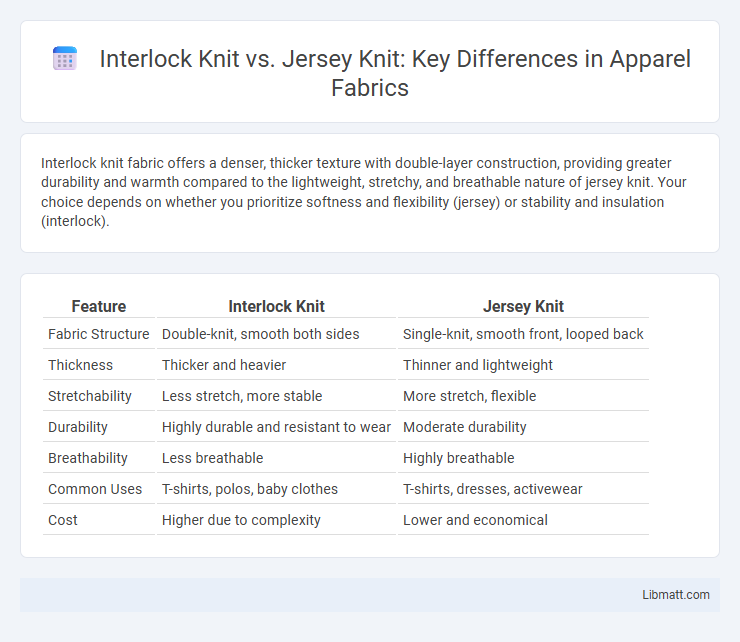Interlock knit fabric offers a denser, thicker texture with double-layer construction, providing greater durability and warmth compared to the lightweight, stretchy, and breathable nature of jersey knit. Your choice depends on whether you prioritize softness and flexibility (jersey) or stability and insulation (interlock).
Table of Comparison
| Feature | Interlock Knit | Jersey Knit |
|---|---|---|
| Fabric Structure | Double-knit, smooth both sides | Single-knit, smooth front, looped back |
| Thickness | Thicker and heavier | Thinner and lightweight |
| Stretchability | Less stretch, more stable | More stretch, flexible |
| Durability | Highly durable and resistant to wear | Moderate durability |
| Breathability | Less breathable | Highly breathable |
| Common Uses | T-shirts, polos, baby clothes | T-shirts, dresses, activewear |
| Cost | Higher due to complexity | Lower and economical |
Introduction to Interlock Knit and Jersey Knit
Interlock knit features a double-knit construction with two layers of fabric, offering a thicker, more durable, and reversible texture that maintains shape well and provides excellent insulation. Jersey knit, a single-knit fabric made from one set of needles, is lighter, more flexible, and has a distinct front and back side, commonly used for T-shirts and lightweight garments. Both fabrics are composed primarily of cotton, polyester, or blends, but interlock knit excels in stability while jersey knit emphasizes breathability and stretch.
Key Differences Between Interlock and Jersey Knit
Interlock knit features a thicker, double-layered fabric with a smooth surface on both sides, offering more durability and insulation compared to jersey knit's single-layer, lightweight fabric with a distinct front and back. Jersey knit tends to stretch more horizontally and drapes fluidly, making it ideal for casual wear, while interlock knit provides greater vertical stretch and structural support, suitable for active or layered garments. Choosing between interlock and jersey knit impacts your fabric's breathability, texture, and longevity based on your specific project needs.
Fabric Structure and Construction
Interlock knit features a double-knit fabric structure with two layers of jersey knit interlocked, creating a thicker, more stable material with minimal stretch and a smooth surface on both sides. Jersey knit, constructed from single rows of interlooped yarns, results in a lightweight, breathable fabric with a distinct front (knit) and back (purl) side, offering more stretch and drape than interlock. Understanding these differences helps You choose the right fabric for comfort, durability, and intended garment use.
Softness and Comfort Comparison
Interlock knit fabric offers a smoother, thicker texture with a double-layered construction, providing enhanced softness and a cozy feel compared to jersey knit. Jersey knit, being lightweight and single-layered, is more breathable but slightly less plush, making it ideal for warm weather or activewear. Your choice depends on seeking either the luxurious comfort of interlock or the airy flexibility of jersey knit.
Stretch and Recovery Properties
Interlock knit fabric offers superior stretch and recovery compared to jersey knit due to its double-knit construction, which provides excellent elasticity and shape retention. Jersey knit, being a single knit fabric, tends to stretch more but may lose its shape over time, especially with frequent wear. When choosing your fabric for garments requiring durability and consistent fit, interlock knit ensures better performance in maintaining stretch and recovery.
Durability and Longevity
Interlock knit fabric exhibits superior durability and longevity compared to jersey knit due to its double-knit construction, which creates a thicker, more stable textile resistant to stretching and pilling. Jersey knit, being a single-knit fabric, tends to wear out faster with frequent washing and use because it is thinner and more prone to snagging and losing shape. Choosing interlock knit is ideal for garments requiring enhanced resilience and sustained appearance over time.
Common Uses in Fashion and Apparel
Interlock knit fabric is widely used for high-quality activewear, baby clothing, and fitted garments due to its thicker, double-knit structure offering durability and stretch. Jersey knit, favored for T-shirts, dresses, and casual wear, provides a lightweight, breathable, and soft texture that drapes well on the body. Both fabrics serve essential roles in fashion, with interlock knit chosen for structure and warmth, while jersey knit excels in comfort and flexibility.
Care and Maintenance Tips
Interlock knit requires gentle care to maintain its smooth texture and durability, so washing in cold water and laying flat to dry is recommended. Jersey knit is more prone to stretching, so using a gentle cycle and avoiding high heat in the dryer helps preserve its shape. To keep your garments looking their best, always follow the specific care instructions on the label for either fabric type.
Pros and Cons of Interlock Knit vs Jersey Knit
Interlock knit fabric offers superior durability, thickness, and a smooth double-knit texture, making it ideal for garments needing extra warmth and structure, but it can be heavier and less breathable than jersey knit. Jersey knit fabric is lightweight, stretchy, and breathable, providing excellent comfort and drape for casual wear, though it tends to be less durable and may lose shape over time. Understanding these pros and cons helps you select the right fabric for your project's comfort, longevity, and aesthetic needs.
Choosing the Right Knit for Your Project
Interlock knit features a thicker, double-layered structure offering excellent durability and stretch, ideal for garments needing more stability and warmth. Jersey knit is lighter and more breathable, making it perfect for casual wear or projects requiring flexible drape and softness. When choosing the right knit for your project, consider the fabric's weight, stretch, and texture to ensure your final product meets your comfort and design needs.
Interlock knit vs jersey knit Infographic

 libmatt.com
libmatt.com